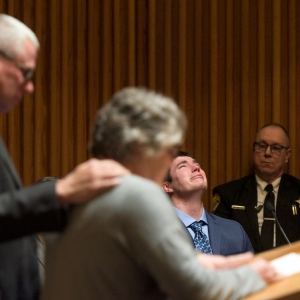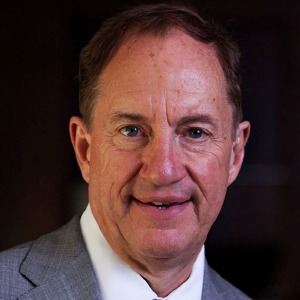As Hartford breaks up encampments, homeless people have nowhere to go
| Published: 10-23-2021 9:39 PM |
Just about a year ago, Keith Gokey moved into a new home in Hartford. It wasn’t much. A 6-by-10-foot cabin with walls made of water-resistant foam sheets and a wood floor raised slightly off the ground to help ward off the elements. A small propane heater warmed him in cold weather.
Even without running water or electricity, the cabin represented a marked improvement over having no home at all, which is where Gokey has often found himself in recent years. At one point, he lived in a tent in the woods.
“I don’t like being around people,” the 55-year-old Gokey told me. “I like being by myself.”
The cabin — and several others in secluded parts of the town — was built by former Hartford Selectboard member Simon Dennis and a small band of advocates for the homeless.
Not everyone in Hartford approves of what Dennis is doing. The cabins, among other things, violate town zoning regulations pertaining to unpermitted structures, opponents argue.
They’re not wrong.
Gokey’s cabin, built in sections, was placed on private property — a clump of woods above Wilder Dam — without the landowner’s permission. In other words, Gokey became a squatter.
The Upper Valley’s severe shortage of affordable housing and Gokey’s own history, which I’ll get into later, make it unlikely that his living situation will improve anytime soon.
Article continues after...
Yesterday's Most Read Articles
 Citing insufficient evidence, county attorney declines to prosecute former Lebanon Public Works employees who were accused of theft
Citing insufficient evidence, county attorney declines to prosecute former Lebanon Public Works employees who were accused of theft
 Dartmouth alumnus gets 20-to-40-year sentence in rape case
Dartmouth alumnus gets 20-to-40-year sentence in rape case
 President of Vermont Law and Graduate School to step down this summer
President of Vermont Law and Graduate School to step down this summer
 Walkout at Dartmouth calls attention to Trump’s attacks on universities, conditions in Gaza
Walkout at Dartmouth calls attention to Trump’s attacks on universities, conditions in Gaza
“Keith has no choice but to break the law,” Dennis said.
With winter approaching, Gokey planned to stay in the woods above Wilder Dam. Hartford officials, however, had other ideas. They wanted the cabin — and by extension, Gokey himself — gone.
Several larger homeless encampments, some of which Dennis had helped establish, were targeted as well.
But since Gokey and the other so-called unhoused weren’t living on town property, Hartford couldn’t easily give them the boot.
For Hartford’s get-tough-on-homelessness plan to succeed, Town Manager Tracy Yarlott-Davis and her staff needed a strategy.
In September, with Yarlott-Davis’ stamp of approval, Deputy Police Chief Brad Vail sent letters to three property owners who may or may not have known they had homeless encampments on their land.
The letters warned the property owners that if they didn’t take action to “prevent unwanted trespassers,” they could face fines and have to “pay the cost of the fire department’s response to extinguish” any unpermitted fires in the encampments.
“To mitigate your liability in such matters” property owners could inform the town that they “desire police action to be taken if trespassers are located,” the letter stated.
The Vermont Agency of Transportation was unaware an encampment existed on state property between Route 14 and the White River before it received the letter, said Joe Ruzzo, the agency’s district administrator for this part of the state.
Last week, a state transportation manager visited the site. It appeared whoever was living there had cleared out, Ruzzo told me.
“Nobody wants to have these situations, but these are people who have fallen on hard times,” he said. “Living outdoors probably isn’t their first choice.”
Jim Flanagan’s family business, Hartford Land Co., also received a letter concerning its property off Pine Street. Hartford Land gave police the go-ahead to clear the encampment that had cropped up. Also, as the town requested, Hartford Land paid a property maintenance company to tend to the site.
While it’s understandable that residents don’t want encampments near their neighborhoods, “the homeless issue is bigger than cleaning up some trash,” Flanagan said. “It’s not going to magically go away.”
Great River Hydro, the Massachusetts company that controls Wilder Dam and the land around it, agreed with the town that Gokey’s campsite should be shut down.
“This area is dangerous due to close proximity to train traffic and the steep embankment to the river, even more so in the winter,” Great River spokesman Matthew Cole told me in an email.
Four of the seven people living in the camps that were cleared in recent weeks have left Hartford, Dennis told me.
Mission accomplished, I guess.
But as Dennis pointed out, that’s “not being a good neighbor to other towns.” By forcing homeless people to seek refuge in other communities, Hartford has likely only made things worse somewhere else.
The unhoused often end up in Hartford because it’s where social services are located. Gokey, like many others in his situation, rely on the Upper Valley Haven’s food shelf to keep from going hungry. There are hot meals at Listen Community Services. The warm coat that Gokey wore the day I met him came from Listen’s thrift store in White River Junction.
By clearing the encampments, the town is “scattering the unhoused farther and farther away from the services they need,” said state Rep. Becca White, D-Hartford.
With cold weather approaching, the town’s timing begs the question: Why now?
I think Yarlott-Davis, who has been on the job for only eight months, is feeling some pressure. A small group of vocal residents has been showing up at Selectboard meetings and taking to social media. The residents claim homelessness is a driver of crime and drug use in town.
I’m not sure their concerns are valid, but I checked with Yarlott-Davis to see if she had information to the contrary. She seemed skeptical as well. In any community, crime and drug problems are “much bigger than one population,” she said.
Heidi Duto has been among the residents pressing town officials at board meetings.
“I’m not against homeless people. Some of them are really struggling,” she told me. “But some are abusing the system. Why are they not trying to get themselves in a position to get jobs and an apartment?”
The people arguing for the town to crack down are not the “villains,” said Sue-Ellen Parmenter, who has not been bashful about criticizing town officials for tolerating the unpermitted cabins.
“We just want things done legally and safely,” she said.
Yarlott-Davis is in a tough spot.
Far from everyone on the seven-member Selectboard — her bosses — have bought into the plan to clear the encampments. With winter on the horizon, some members seem frustrated that Yarlott-Davis and her staff have not worked more closely with the Ad-Hoc Committee on Emergency Shelter, which the board established last December.
“We’re going to have people dying because there is no place for them to be, and that’s not OK,” Selectboard Chairman Dan Fraser said at Tuesday’s meeting. “People need places to live.”
After talking with Yarlott-Davis for nearly an hour on Friday, I sensed she wasn’t completely comfortable with her decision to clear the encampments. But with the regulations on Hartford’s books that prohibit unpermitted structures and fires, Yarlott-Davis apparently didn’t think she had much choice.
“It’s why some people don’t want to get into this line of work,” said Yarlott-Davis, who was a government auditor in two California cities — Berkeley and Oakland — before getting hired in Hartford. “You can’t always do what you want.”
U.S. communities big and small are grappling with how to ease homelessness.
In Burlington, city officials announced earlier this month that 20 to 30 homeless people camping on public land had until Oct. 19 to move out.
But after protesters took to the city’s downtown, Mayor Miro Weinberger, who grew up in Hartland, extended the deadline until this coming Tuesday. City officials also agreed to use state money to relocate the camp’s residents.
In 2019, the federal government estimated that nearly 568,000 Americans were homeless. The figure was considered badly out of date at the time and the feds have no reliable method to track homelessness, The New York Times’ editorial board wrote earlier this year.
The number of homeless people in Hartford and other Upper Valley communities is also difficult to pin down.
White told me that she knows of at least 10 people who are unhoused in town. Dennis estimates it could be twice that figure.
White and Dennis serve on the town’s Emergency Shelter Committee, which the Selectboard established in the throes of the pandemic.
At Tuesday’s board meeting, White and Dennis, speaking on behalf of the committee, asked that the town’s zoning regulations be modified to make them friendlier to homeless encampments.
The committee is proposing the town allow recreational vehicles — RVs — to be used as “sleeping quarters” beyond the current limit of 14 days a year. (Permitted campgrounds are an exception.)
The committee also wants to increase the number of RVs allowed on private property from one to three. A zoning permit and fire-safety inspection would still be required. The definition of an RV, however, would likely be expanded to include small manufactured structures and cabins along the lines of those that Dennis built.
“We’re in a dire situation, and we don’t have multiple alternatives,” White told the board.
Although the town’s planning department and the emergency shelter committee have been in talks for about six months, it has amounted to little progress.
On Tuesday, Planning Director Lori Hirshfield explained that any proposed amendment must pass muster with the Planning Board, a process that can take months.
“Unfortunately, the (proposed) policy change is not going to occur in time to meet the demands we’re going to see in the coldest days of January,” White told me after the meeting. “I don’t know what’s going to happen, but we’re certainly letting these (unhoused) folks down.”
On a sunny early-October morning, Gokey helped Dennis and a few other volunteers dismantle the cabin that he called home.
“I’m going to miss it here,” Gokey said.
Gokey, who has a slender build and wears a baseball cap that covers his red hair, talked about walking down to the Connecticut River to catch his supper.
“I love walleye,” he said.
He had a cookstove and built a small fire pit. The cabin had an air vent and a meter that monitored carbon monoxide levels.
Gokey was often “gone all day” before returning at night to “sleep and get out of the weather,” he said.
On his way out of the campsite most mornings, he passed through an industrial park and a residential neighborhood before catching Advance Transit, the Upper Valley’s free bus service.
He worked for a landscaper. He also earned a few bucks at Liberty Tax, a tax preparation service with an office in West Lebanon.
You might have seen him. He was the guy dressed in a silver Statue of Liberty costume who waved to motorists on Main Street.
On the days he worked, as well as those he didn’t, Gokey didn’t always head straight back to his campsite. He’d hang out in downtown White River Junction, which wasn’t always a good decision.
Gokey acknowledges that alcohol is one of his demons. Some nights, if he’d had too much to drink, Hartford police gave him rides back to the campsite, he said. On winter’s coldest days, they’d stop by to make sure he was OK.
Hartford police have been “pretty good to me,” he said during an interview at the campsite. “I realize if I’m going to drink, I’m better off being back. I can’t cause trouble here.”
Bill Soule met Gokey about 15 years ago. Gokey had just been released from prison after serving more than three years for sexual assault of a juvenile.
Soule headed the Vermont Department of Corrections’ probation and parole office in Hartford. While under department supervision, Gokey spent a few years in and out of prison for violating conditions of release.
In spite of the setbacks, Soule told me that he found Gokey to be a hard worker who is “generally polite and admits when he is wrong.”
Gokey completed his sentence in 2012, which I take to mean that he’d paid his debt to society. He deserved the right to get on with his life.
Except it often doesn’t work that way. Gokey remains on Vermont’s sex offender registry, where he’s described as “not high risk.”
Just being on the registry limits his housing options. Public housing is more or less out of the question. I don’t imagine many private landlords are interested in renting to him, either. The Haven doesn’t allow people on the sex offender registry to stay at its adult shelter, which is adjacent to its family shelter.
Someone recently posted Gokey’s photo and sex offender registry information on the Facebook page “What’s up Hartford,” which seems to be a popular online gathering place for people trying to rid the town of its unhoused.
“Keith is a prime example of someone who falls between the cracks in our society,” said Soule, who now leads the Department of Corrections’ effort to overhaul its women’s prison. “If he had a roof over his head, work and someone to mentor him, he could be successful.”
I recently heard that Gokey is back in his same cabin, just in a different town. How long he goes undetected before he’s forced to move again is anyone’s guess.
It’s no way to live. But in a society that often views the homeless as a nuisance, what other option does he have?
Jim Kenyon can be reached at jkenyon@vnews.com.
]]>






 Newport school’s bat colony to be removed over spring break
Newport school’s bat colony to be removed over spring break Upper Valley Haven executive director to step down
Upper Valley Haven executive director to step down
